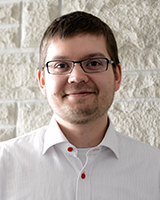Andrew Pruszynski

Associate Professor
PH.D. Queen's University
B.Ap.Sci. Simon Fraser University
Office: Robarts Research Institute 1254A
p. 519.663.5777 x.24384
e. andrew.pruszynski@uwo.ca
Visit: Dr. Prusynski's Homepage
See Publications by Andrew Pruszynski on PubMed
Join
I am looking for enthusiastic graduate students and post-doctoral fellows. If you are interested in the neural mechanisms of sensory perception and motor control, please email me a copy of your CV along with a brief description of your scientific interests and career goals.
Neural mechanisms underlying sensory perception and motor control
Motor behavior and sensory perception appear effortless but actually reflect a myriad of complex interactions between the mechanical properties of the body and a highly distributed neural circuit. The goal of my research is to explain how the nervous system handles and exploits these interactions when moving the arm and manipulating objects with the hands. Addressing this issue is essential to our basic understanding of sensorimotor function and may lead to better treatment following trauma (e.g. nerve and spinal cord injury) and disease (e.g. ALS) which often disrupt these interactions. In my lab, tackling this issue is a multi-disciplinary affair, including neurophysiological studies at various levels of the nervous system, targeted modeling efforts, behavioral and psychophysical studies, and patient work.
Selected Publications
Pruszynski JA, Johansson, RS. (2014) Edge-orientation processing in first order tactile neurons. Nature Neuroscience 17(10): 1404-1409.
Pruszynski JA, Omrani M, Scott SH. (2014) Goal-dependent modulation of fast feedback responses in primary motor cortex. J Neurosci. 34(13):4608-17
Pruszynski JA, Scott SH. (2012) Optimal feedback control and the long-latency stretch response. Exp Brain Res. 218(3):341-59.
Pruszynski JA, Kurtzer I, Nashed JY, Omrani M, Brouwer B, Scott SH. (2011) Primary motor cortex underlies multi-joint integration for fast feedback control. Nature. 2011 478(7369):387-90.
Pruszynski JA,Kurtzer I, Scott SH. (2011) The long-latency reflex is composed of at least two functionally independent processes. J Neurophysiol. 106(1):449-59.
Pruszynski JA, King GL, Boisse L, Scott SH, Flanagan JR, Munoz DP. (2010) Stimulus-locked responses on human arm muscles reveal a rapid neural pathway linking visual input to arm motor output. Eur J Neurosci. 32(6):1049-57.
Pruszynski JA, Lillicrap TP, Scott SH. (2010) Complex spatiotemporal tuning in human upper-limb muscles. J Neurophysiol. 103(1):564-72.
Pruszynski JA, Kurtzer I, Scott SH. (2008) Rapid motor responses are appropriately tuned to the metrics of a visuospatial task. J Neurophysiol. 100(1):224-38.
Kurtzer IL, Pruszynski JA, Scott SH. (2008) Long-latency reflexes of the human arm reflect an internal model of limb dynamics. Curr Biol. 18(6):449-53.








